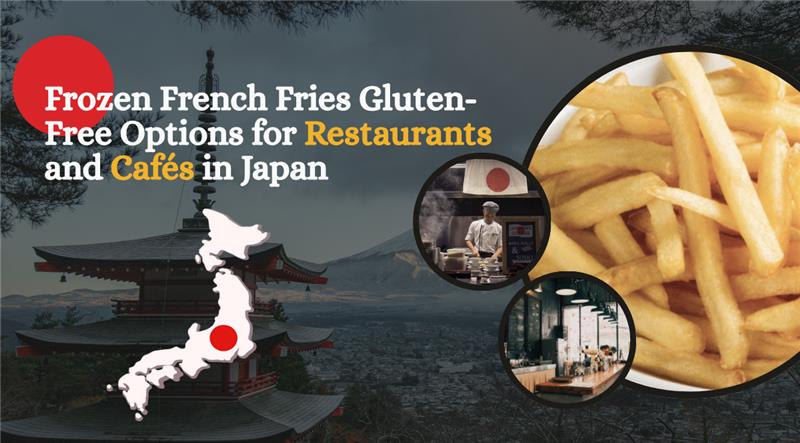Have you ever lost a customer because your fries couldn’t be eaten by someone with gluten sensitivity? Or felt stuck choosing between speed and serving everyone safely? If so, you’re not alone. Many cafés, restaurants, and QSRs in Japan struggle with two big problems: cross-contamination and limited choices in gluten-safe sides.
Enter frozen french fries gluten free. Yes — fries that are naturally safe, fast to cook, and appeal broadly. When you offer frozen french fries gluten free, you open your menu to more people, improve trust, and often gain repeat business from guests who need (or prefer) gluten-free options.
In this blog, I’ll cover:
- Are frozen french fries naturally gluten-free?
- How to ensure gluten-free safety in your kitchen.
- Tips for restaurants and cafés choosing these products.
Ready to transform your side dish game and make gluten free frozen french fries Japan style a standard in your place? Let’s go.
Are Frozen French Fries Naturally Gluten-Free?
You may think: “Potatoes + oil + salt = totally gluten-free.” But it’s not always that simple.
What you need to know:
- Potatoes themselves are gluten-free. That part is easy.
- The risk comes when fries are processed in factories that also handle wheat, or when additives/coatings contain gluten. A common problem is flavorings or coatings made with wheat flour.
- Also, in the restaurant kitchen: shared fryers. If your fryer also cooks battered chicken or breaded items, even “plain” fries may pick up gluten.
So, for your menu to confidently say “we serve frozen french fries gluten free”, you need:
- A product labeled gluten-free with ingredient and facility info e.g Pepizo’s Gluten Free Frozen French Fries.
- Proof that processing was done in a facility controlling gluten contamination.
In Japan, consumers are becoming more aware of allergens and food labeling. When you offer gluten free frozen french fries in Japan, you don’t just tick a box — you build credibility.
How to Ensure Gluten-Free Safety in Kitchens
You got the right product. Now, how to make sure nothing messes it up before it reaches the guest?
Here are best practices many successful cafés/QSRs follow:
| Step | What to check or do |
| Separate equipment | Use a dedicated fryer for gluten-free frozen french fries, or at least ensure the fryer is cleaned and oil changed if there was cross-contact risk. |
| Staff training | Train your kitchen team. Make sure everyone knows what “gluten free frozen french fries” means. No breaded food in same basket, no shared utensils. |
| Labeling & communication | On your menu, mark the gluten free frozen french fries clearly. If possible, show a logo, or mention it. When customers ask, staff should explain confidently. |
| Check supplier certificates | Suppliers should provide documentation: allergen statement, facility safety, processing details. |
| Clean surfaces & utensils | Boards, knives, baskets – anything that touches the fries needs to be clean and free of gluten residue. |
| Ingredient transparency | Even seasoning or oil additives matter. A “just salt and potato” approach is safest. |
If your restaurant or café can consistently serve safe, tasty gluten free frozen french fries, you win trust. And trust means loyalty. More people will choose you when they know you take their dietary needs seriously.
Gluten Free Options for Restaurants: What to Look for
Choosing the right frozen french fries gluten free product isn’t just about seeing “gluten free” on the bag. Here are what business owners in Japan should demand:
- Clear label “Gluten-Free” plus allergen chart showing “no wheat/barley/rye.”
- Facility info: are they processed in dedicated gluten free / allergen-controlled lines?
- Minimal ingredients: potatoes, oil, maybe salt. The fewer additives, the lower risk.
- No breading or coatings involving wheat.
- Long shelf stability in freezer, with product texture maintained after cooking.
- Easy cooking / crisp finish: important when speed matters.
Why Offering Gluten Free Frozen French Fries Japan Style Can Be a Game-Changer
Let’s talk about what’s in it for you, as a business.
- Open up to more customers:
Gluten intolerance, celiac disease, or simply preference — more people in Japan care about health and allergens. A safe fry option makes you more inclusive. - Stand out from competition:
Many places still don’t clearly offer gluten-free frozen french fries. You can be the café or restaurant people mention: “They have safe fries!” - Simplify kitchen operations:
Instead of modifying every dish, you can have a standard safe side that works with many mains. “Gluten-free options for restaurants” often means less complexity when you plan and prep. - Higher perceived value:
Guests are often willing to pay a bit more for peace of mind. Safe sides can allow you to raise price slightly on combo meals. - Stronger reputation and reviews:
Social media, reviews — when you offer gluten free frozen french fries Japan style, people notice. That builds online word of mouth.
Common Objections & How to Overcome Them
You might think:
- “Special fryer is expensive.” Yes, but starting with one dedicated fryer (or time-slots) can offset cost. Long-term savings in fewer complaints, fewer returns.
- “Customers won’t care about gluten-free if they love regular fries.” They might not until they need it. When someone has to avoid gluten and you’re an option, they’ll remember.
- “Gluten-free fries cook differently or taste different.” Good suppliers and correct practice can deliver fries that taste just like regular ones. Texture and crispiness should match.
Tips for Restaurants and Cafés in Japan Making the Switch
If you decide to add gluten free frozen french fries to your menu, here are some actionable tips:
- Start by testing with your regular customers. Offer a combo with gluten free fries. Get feedback.
- Use private label and promote on social media as proof: advertise you offer “gluten free options for restaurants” and post images of crispy fries labelled safe. It brings in customers who care. You
- Partner with trustworthy suppliers like Pepizo Foods for consistent consistent products. Talk about real shelf life, real certificate, real taste.
How Pepizo Foods Delivers What You Need?
Now, let’s talk about the supplier side — because even if you do everything right, a weak supply chain can break trust.
Pepizo Foods understands the challenges restaurants and cafés in Japan face when sourcing gluten free frozen french fries. Here’s how Pepizo works to make your life easier:
- We offer varieties that are certified or tested safe for gluten, with clear product labeling.
- Our freezing, packaging, and processing methods aim to reduce any risk of cross‐contamination.
- We supply in bulk, so you maintain consistency across all your locations. We also provide private labelling for bulk orders.
- Our products deliver texture, crisp after frying or baking, so guests feel they haven’t “given up” anything.
- Pepizo’s export to Japan process meets Japanese import standards. So no surprises at customs or quality checks.
Final Thoughts: Make the Switch & Grow
So what’s the takeaway?
If you want to win more customers, reduce mistakes in the kitchen, and build a menu that feels both premium and safe — frozen french fries gluten free should be on your radar.
Offering gluten free frozen french fries Japan style means being inclusive, adding perceived value, and making your operations smoother.
So what are you waiting for? Connect with us to know more about bulk orders.



